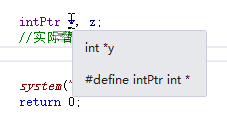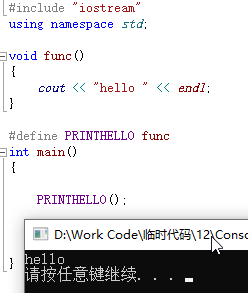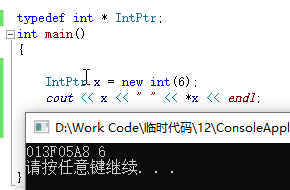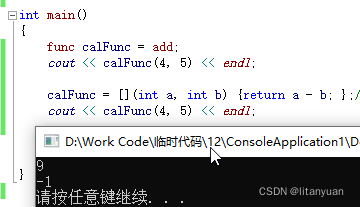C++中定义别名的几种方式总结
背景
在代码编辑过程中,为了书写省事或者更容易理解,通常会自定义别名,包括类型别名、方法别名等。在 C++ 中定义别名有以下几种方式。
#define
①.概述
#define 是宏定义,作用就是将一个标识符定义为一个字符串,源程序中所有的该标识符均以指定的字符串代替,在预编译阶段执行。
②.定义类型别名
#include "iostream"
using namespace std;
#define intPtr int * //定义一个 int * 指针类型
int main()
{
intPtr x = new int(6);
cout << x << " " << *x << endl;
system("pause");
return 0;
}
运行结果如下:
宏定义仅进行文本替换,若连续定义变量,则可能和预期不符:
intPtr y, z;
//实际替换结果:int * y,z;
编译器中查看如下,变量y\z类型不一样:
③.定义函数别名
#include "iostream"
using namespace std;
void func()
{
cout << "hello " << endl;
}
#define PRINTHELLO func
int main()
{
PRINTHELLO();
system("pause");
return 0;
}
运行结果如下:
typedef
①.概述
typedef是用来申请类型别名的,本质是为数据类型起了一个别名,也相当于定义了一个新的类型。
②.定义数据类型
#include "iostream"
using namespace std;
typedef int * IntPtr;
int main()
{
IntPtr x = new int(6);
cout << x << " " << *x << endl;
system("pause");
return 0;
}
运行结果如下:
③.定义数组类型
typedef char mysize[10];
mysize m_array;
④.定义结构体类型
typedef struct m_struct
{
char c;
}s;
s m_struct;
⑤.定义函数类型
#include "iostream"
using namespace std;
typedef int func(int a,int b);
int add(int a, int b)
{
return a + b;
}
int sub(int a, int b)
{
return a - b;
}
int main()
{
func * calFunc;
calFunc = add;
cout << calFunc(4, 5) << endl;
calFunc = sub;
cout << calFunc(4, 5) << endl;
system("pause");
return 0;
}
但是使用 typedef 定义的函数类型定义的非指针变量不可以直接赋值:
typedef int func(int a,int b);
func f = add;//出错
可用于函数声明:
#include "iostream"
using namespace std;
typedef int func(int a,int b);
func add;//声明一个函数
int main()
{
system("pause");
return 0;
}
//函数定义
int add(int a, int b)
{
return a + b;
}
⑥.定义函数指针
#include "iostream"
using namespace std;
typedef int (*func)(int a,int b);
int add(int a, int b)
{
return a + b;
}
int main()
{
func calFunc = add;
cout << calFunc(4, 5) << endl;
calFunc = [](int a, int b) {return a - b; };//含捕获列表时不可以赋值
cout << calFunc(4, 5) << endl;
system("pause");
return 0;
}
运行结果:
⑦.模板类型别名
template <typename Val>
struct strMap
{
typedef map<string, Val> type;
};
strMap<int>::type m_map;
using
①.概述
c++11中通过 using来定义别名,比typedef更容易阅读
②.定义类型别名
using intPtr = int *;
intPtr x = new int(6);
③.定义函数指针别名
#include "iostream"
using namespace std;
using func = int(*)(int a, int b);
int add(int a, int b)
{
return a + b;
}
int sub(int a, int b)
{
return a - b;
}
int main()
{
func calFunc = add;
cout << calFunc(4, 5) << endl;
system("pause");
return 0;
}
④.定义函数指针别名
#include "iostream"
using namespace std;
using func = int (int a, int b);
int add(int a, int b)
{
return a + b;
}
int sub(int a, int b)
{
return a - b;
}
int main()
{
func *calFunc = add;
cout << calFunc(4, 5) << endl;
system("pause");
return 0;
}
⑤.模板类型别名
template <typename Val>
using strMap = map<string, Val> type;
// 使用using 更方便
strMap<int> m_map;






